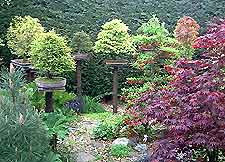Bonsai Trees
Choosing Trees and Sources

There are faults that should be avoided when selecting material for bonsai, as they may prove difficult to correct. These include inverse taper of the trunk, ugly grafts, one-sided or non-existent surface roots and branches that are too thick.
Inadequate branches can be improved with careful pruning and shaping, but only if they are in good positions to start with. Bar branches that emerge at the same height from opposite sides of the trunk are undesirable, looking contrived and unnatural. The lowest branches should normally be the largest and grow to one side, rather than straight towards the front.
A poor branch structure can, with time, be regrown on most deciduous trees. This is likely to be a long-term process, but worth persevering with if the tree has other redeeming features, such as a good trunk line or well developed surface roots. However, this is not really an option with most conifers, although these species do have the advantage that they are evergreen and therefore some faults may possibly be hidden by the foliage.
When purchasing a bonsai tree or potential material, if a number of trees are available, considerable time can be saved by choosing a tree that exhibits the fewest faults, but still has the potential to become a good bonsai. However, small faults can become interesting features of a bonsai, helping to give individual character and interest.
Seed
Cuttings
Air Layering
Bonsai Nurseries
Collecting from Gardens
Collecting from the Wild
Garden Centre Stock
 There are faults that should be avoided when selecting material for bonsai, as they may prove difficult to correct. These include inverse taper of the trunk, ugly grafts, one-sided or non-existent surface roots and branches that are too thick.
There are faults that should be avoided when selecting material for bonsai, as they may prove difficult to correct. These include inverse taper of the trunk, ugly grafts, one-sided or non-existent surface roots and branches that are too thick.